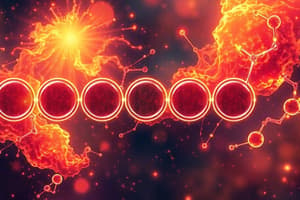Podcast
Questions and Answers
BLANK are the derivatives of alkanes in which hydrogen atom is replaced by a halogen atom F, Cl, Br, or I
BLANK are the derivatives of alkanes in which hydrogen atom is replaced by a halogen atom F, Cl, Br, or I
ALKYL HALIDES (F, CL, Br, or I)
Represented by R-X-R-alkyl group, X-halogen like chloro, Fluoro, Bromo, and Iodo group
Represented by R-X-R-alkyl group, X-halogen like chloro, Fluoro, Bromo, and Iodo group
ALKYL HALIDES
compounds with a halogen atom bonded to a saturated, sp3- hybridized carbon atom.
compounds with a halogen atom bonded to a saturated, sp3- hybridized carbon atom.
ALKYL HALIDES
halide is attached to a methyl group.
halide is attached to a methyl group.
carbon to which halogen is bonded is attached to only one other carbon.
carbon to which halogen is bonded is attached to only one other carbon.
carbon to which halogen is bonded is attached to two other carbons.
carbon to which halogen is bonded is attached to two other carbons.
carbon to which halogen is bonded is attached to three other carbon.
carbon to which halogen is bonded is attached to three other carbon.
Classifications of Alkyl Halides
Classifications of Alkyl Halides
Only one additional alkyl group is bonded to the carbon that bears the halogen atom.
ONE CARBON ATOM
Only one additional alkyl group is bonded to the carbon that bears the halogen atom. ONE CARBON ATOM
the halogenated carbon is connected straight to two more alkyl groups, which might be the same or different
TWO CARBONS CONNECTED
the halogenated carbon is connected straight to two more alkyl groups, which might be the same or different TWO CARBONS CONNECTED
Three alkyl groups, which may be the same or different, are immediately linked to the carbon atom carrying the halogens
THREE CARBONS CONNECTED
Three alkyl groups, which may be the same or different, are immediately linked to the carbon atom carrying the halogens THREE CARBONS CONNECTED
Two general trends relative to boiling points and melting points of halogenated
hydrocarbons containing a single halogen atom are:
Two general trends relative to boiling points and melting points of halogenated hydrocarbons containing a single halogen atom are:
Boiling points and melting points increase as the size of the alkyl group present increases. (This is due to increasing intermolecular forces associated with increased molecular surface area)
Boiling points and melting points increase as the size of the alkyl group present increases. (This is due to increasing intermolecular forces associated with increased molecular surface area)
Boiling points and melting points increase as the size of the halogen atom increases from fl uorine (F) to iodine (I).
Boiling points and melting points increase as the size of the halogen atom increases from fl uorine (F) to iodine (I).
PRIMARY Alkyl halides are slightly soluble in water, but more soluble in organic solvents.
PRIMARY Alkyl halides are slightly soluble in water, but more soluble in organic solvents.
As the amount of alkyl group increases, the acidity decreases
As the amount of alkyl group increases, the acidity decreases
The bond strength of C–X decreases as the size of X increases => iodine is a better leaving group than fluorine
The bond strength of C–X decreases as the size of X increases => iodine is a better leaving group than fluorine
the alkyl halides are highly reactive, the order of reactivity is:
the alkyl halides are highly reactive, the order of reactivity is:
The high reactivity of alkyl halides can be explained in terms of the nature of C X bond which is a HIGHLY POLARIZED COVALENT BOND due to the large difference in the electronegativities of carbon and halogen atoms.
The high reactivity of alkyl halides can be explained in terms of the nature of C X bond which is a HIGHLY POLARIZED COVALENT BOND due to the large difference in the electronegativities of carbon and halogen atoms.
Halogens are more electronegative than carbon atoms. Therefore, the electron density along the C–X bond is shifted towards X the C–X bond is polar. Alkyl halides exhibit dipole-dipole interactions due to the polar C-X bond
Halogens are more electronegative than carbon atoms. Therefore, the electron density along the C–X bond is shifted towards X the C–X bond is polar. Alkyl halides exhibit dipole-dipole interactions due to the polar C-X bond
ALKYL HALIDES OF PHARMACEUTICAL IMPORTANCE
ALKYL HALIDES OF PHARMACEUTICAL IMPORTANCE
used for dry cleaning, spot removing
used for dry cleaning, spot removing
used to dissolve the caffeine from coffee beans to produce decaffeinated coffee
used to dissolve the caffeine from coffee beans to produce decaffeinated coffee
Solvents 2 types
Solvents 2 types
starting materials for making complex molecules
starting materials for making complex molecules
for example, the conversion of alkyl halides to organometallic reagents (compounds containing carbon metal bonds) is important tool for organic synthesis
for example, the conversion of alkyl halides to organometallic reagents (compounds containing carbon metal bonds) is important tool for organic synthesis
One major use of BLANK has been as propellants in aerosol inhalers for drugs used to treat asthma
One major use of BLANK has been as propellants in aerosol inhalers for drugs used to treat asthma
BLANK used originally as general anesthetic but it is toxic and carcinogenic.
BLANK used originally as general anesthetic but it is toxic and carcinogenic.
is a mixed halide sold as Halothane®
is a mixed halide sold as Halothane®
are used as refrigerants and foaming agents.
are used as refrigerants and foaming agents.
Freons can harm the ozone layer so they have been replaced by
Freons can harm the ozone layer so they have been replaced by
Pesticides such as BLANK are extremely toxic to insects but not as toxic to mammals.
Pesticides such as BLANK are extremely toxic to insects but not as toxic to mammals.
can not be destroyed by bacteria so they accumulate in the soil to a level which can be toxic to mammals, especially, humans.
can not be destroyed by bacteria so they accumulate in the soil to a level which can be toxic to mammals, especially, humans.
Colorless, extremely flammable gas with a mildly sweet odor
Colorless, extremely flammable gas with a mildly sweet odor
present in volcanic gases; produced by algae and giant kelp; used as an industrial solvent; once used widely as a refrigerant; no longer found in consumer products because of toxicity concerns
present in volcanic gases; produced by algae and giant kelp; used as an industrial solvent; once used widely as a refrigerant; no longer found in consumer products because of toxicity concerns
Colorless, volatile liquid with a mildly sweet odor
Colorless, volatile liquid with a mildly sweet odor
chemical intermediate in production of silicone polymers; used as a paint stripper and degreaser; once used to decaffeinate coffee but has been replaced by liquid carbon dioxide due to concern about trace amounts of BLANK remaining in the coffee
chemical intermediate in production of silicone polymers; used as a paint stripper and degreaser; once used to decaffeinate coffee but has been replaced by liquid carbon dioxide due to concern about trace amounts of BLANK remaining in the coffee
Flashcards are hidden until you start studying



